Page 1 of 2
FOCUS STACKING Tutorial butterfly portrait
Posted: Sat Oct 23, 2010 7:08 pm
by GOLDENORFE
a series of shots showing how i shoot a high magnification butterfly head focus stack.
all 5 frames of stack are shown which have been converted from raw files and just resized for web.
stacking was performed by zerene stacker -
http://zerenesystems.com/stacker/
there is a free program combine czp that is also very good -
http://www.hadleyweb.pwp.blueyonder....stallation.htm
to start shooting i hold the stem with perched butterfly in left hand, holding a leaf between fingers to give background colour.
the lens is suported by my thumb or fingers and slid along to change focus points as frames are shot.
everything is therefore kept steady,if my hand moves slightly so does the stem and butterfly, which means all frames are quite well aligned.
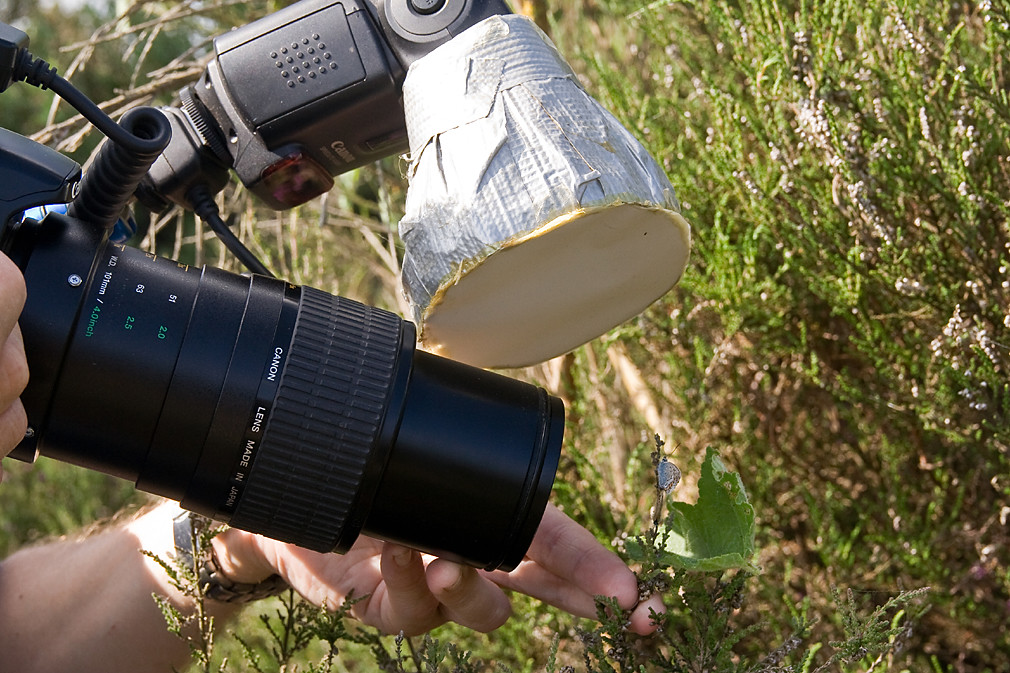
resting lens on thumb for support, the blue male butterfly is the one i was shooting

here are the five frames as shot,just converted from raw files and shown resized for web.only slight different focus planes, starting with the nearest hairs towards the camera and shooting each consecutive frame further into the subject , the last of the five frames has the back hairs on the nose in focus.
you can see they are not exactly aligned but zerene stacker still aligned them pretty good. i then used "edit" to clone all the best, sharpest areas.
#1 USED FOR HAIRS NEAREST ON SHOULDER AREA AND ANTENNA DETAILS

#2 THIS IS THE MAIN FRAME WITH WING DETAIL

#3 EYE DETAIL AND WING SCALES and HAIRS BOTTOM RIGHT CORNER
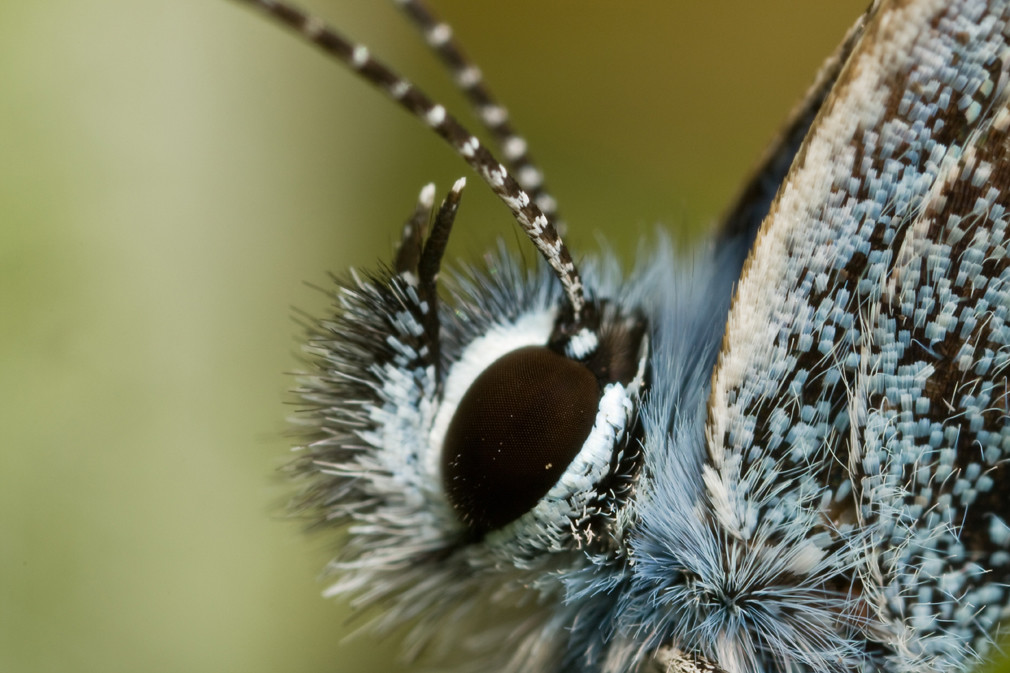
#4 HAIRS AROUND THE HEAD
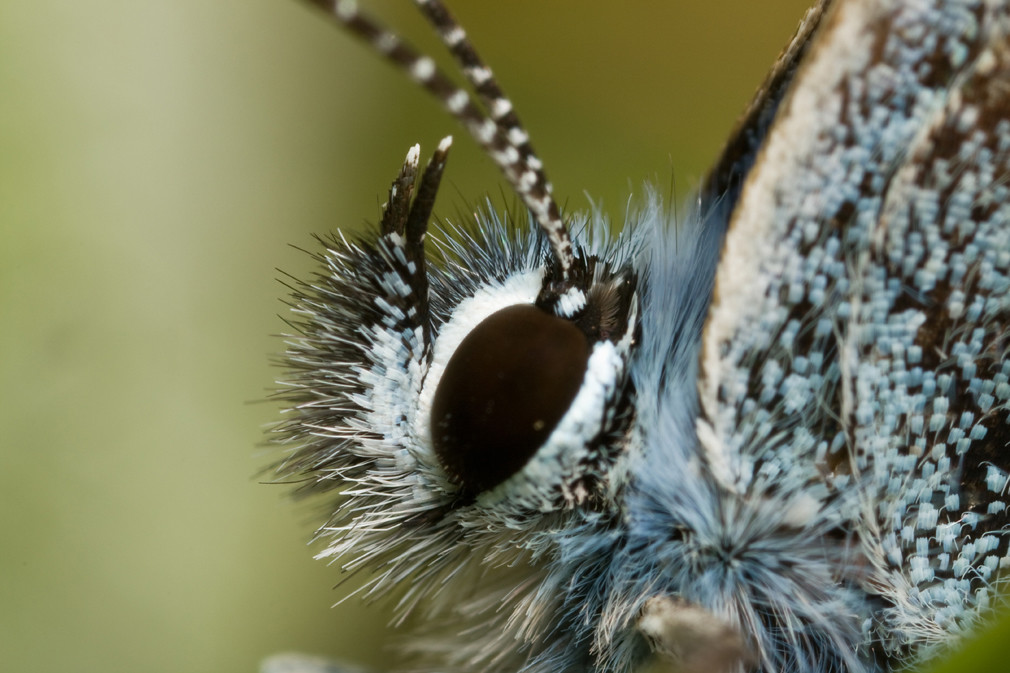
#5 HAIRS BACK OF HEAD
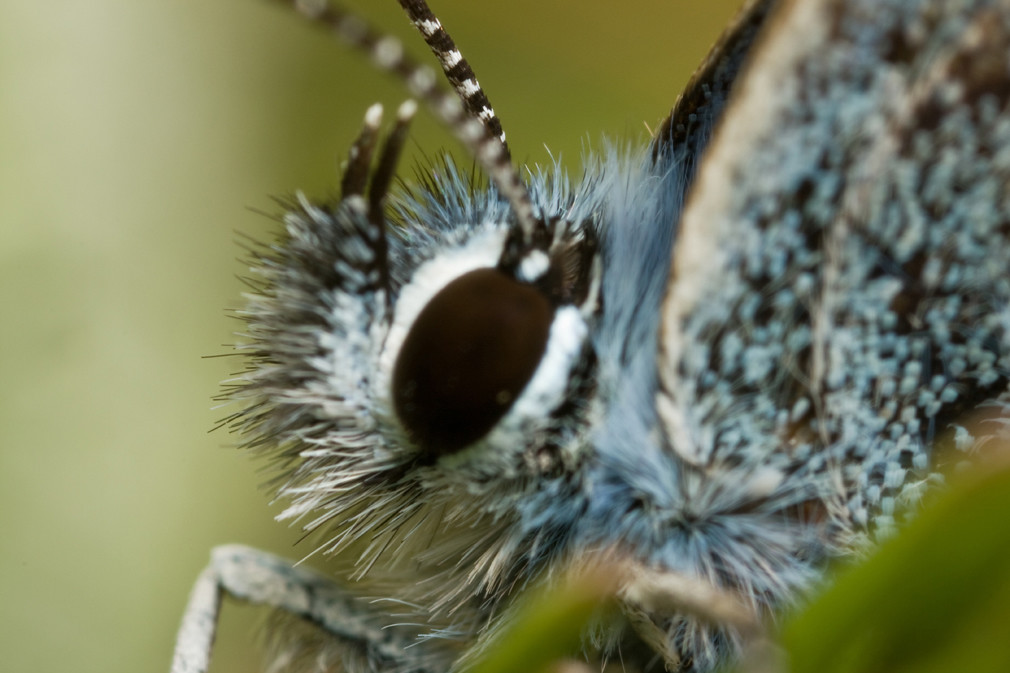
here is the finished image after stacking,minor adjustments with layer masks in ps. levels/contrast adjustment and very slight crop to remove stacking marks around edge , re size for web and unsharp mask
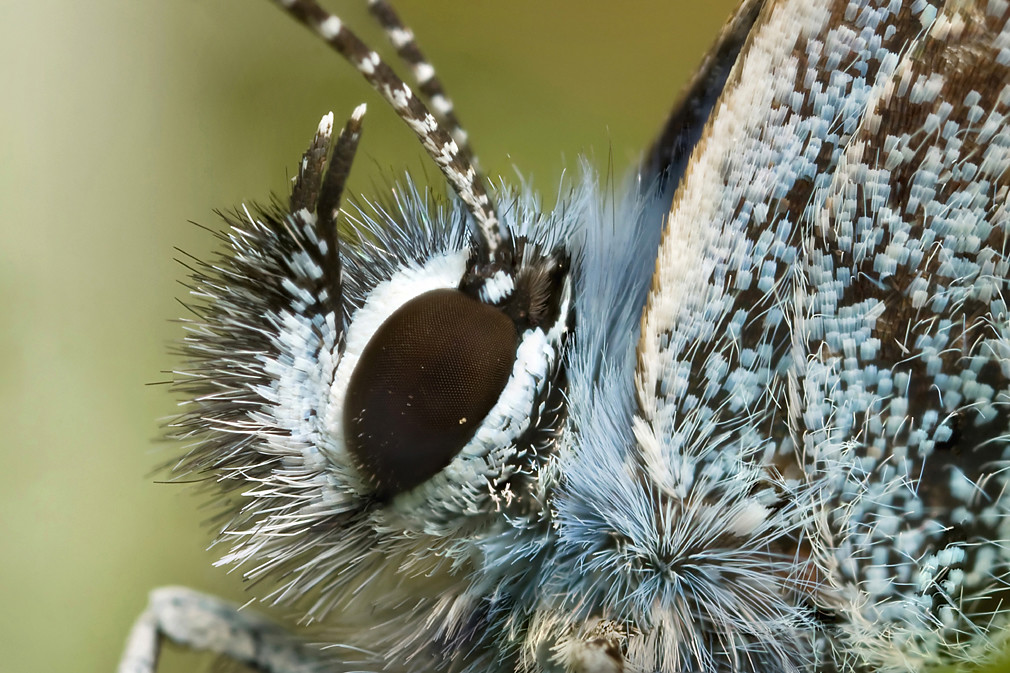
HOPE THIS IS HELPFULL
PHIL
Re: FOCUS STACKING Tutorial butterfly portrait
Posted: Sat Oct 23, 2010 7:11 pm
by David M
Fascinating stuff. The level of detail is quite extraordinary.
Re: FOCUS STACKING Tutorial butterfly portrait
Posted: Sat Oct 23, 2010 7:38 pm
by Jack Harrison
Quite brilliant. But while I can see the immense value from a scientific perspective, it isn't quite how we humans see and enjoy butterflies.
Normally, a blurred background is the most effective. But there are surely occasions when there is a case for a totally sharp subject that is shown in it's habitat/environment with the background also being sharp. This is where photo stacking could be valuable for general (ie non-scientific) enjoyment.
Jack
Re: FOCUS STACKING Tutorial butterfly portrait
Posted: Sat Oct 23, 2010 8:05 pm
by Pete Eeles
Thanks for the detailed explanation Phil! As someone interested in super-macro, this is very helpful. Thanks for sharing.
Cheers,
- Pete
Re: FOCUS STACKING Tutorial butterfly portrait
Posted: Sat Oct 23, 2010 8:23 pm
by Padfield
Phil, you're the man we've all been waiting for!

Have you got any super-macro shots of the tibial spine on the forelegs of silver-stud?

I'd love to see what that really looks like in real life, from close up.
Guy
EDIT: There's a tiny spine visible on the fore tibia in your ant picture. Was that a male? The colour looks male but for some reason I thought ants attended the females.
Re: FOCUS STACKING Tutorial butterfly portrait
Posted: Sat Oct 23, 2010 9:08 pm
by GOLDENORFE
HANKS FOR LOOKING
GUY - i still have a folder of shots with ants i havnt looked at, spur maybe visible on some of them.
the ants tend both male and female, the shot is a male
phil
Re: FOCUS STACKING Tutorial butterfly portrait
Posted: Sun Oct 24, 2010 7:06 am
by Zonda
Fascinating method Phil, and you obviously have it down to a tee. Myself though,, i could never do it, because i have a slight 'lager shake', and i wear insect repellent.

What this means is that the butterfly would probably take flight. Your pics are always a treat to see though. When i was getting 'Clegged' during the summer, your shots of the Horse fly mouth parts were really comforting.

Re: FOCUS STACKING Tutorial butterfly portrait
Posted: Sun Oct 24, 2010 11:40 am
by Jack Harrison
I certainly plan to try zerene but not just yet. I am getting a new computer this week (actually, getting the parts - son will assemble. And yes, he has done it several times before). I will certainly be trying out zerene and while I have little doubt that the results are superb, I might find it a little difficult to use. I'll try out first before buying.
I will undoubtedly experiment with macro but I'm also interested in stacking images of different exposures. I have seen some amazing results showing the increased dynamic range in landscape shots with lots of detail in the shadows and the highlights.
Jack
Re: FOCUS STACKING Tutorial butterfly portrait
Posted: Tue Nov 02, 2010 12:57 pm
by NickMorgan
Wow. This is fascinating and what a fantastic result. How on earth to you get the butterflies to stay put when you approach it with such a large camera, leaf around the back, etc?
Re: FOCUS STACKING Tutorial butterfly portrait
Posted: Tue Nov 02, 2010 4:12 pm
by David M
Some butterflies are more approachable than others. I doubt anyone would be able to do that with a Dark Green Fritillary or a male Orange Tip.
Re: FOCUS STACKING Tutorial butterfly portrait
Posted: Tue Nov 02, 2010 5:05 pm
by Gruditch
No Dave, when at rest an Orange-tip is one of the most approachable butterflies out there. I find that most the spring butterflies are easy, as when the sun goes behind the clouds, then usually the temperature drops enough for them to become inactive.

For the summer species, its a matter of being on site early in the morning, or late afternoon. Of course this only works for the species that don't flee to the trees for the night.
Regards Gruditch
Re: FOCUS STACKING Tutorial butterfly portrait
Posted: Tue Nov 02, 2010 7:57 pm
by David M
Gruditch wrote:No Dave, when at rest an Orange-tip is one of the most approachable butterflies out there. I find that most the spring butterflies are easy, as when the sun goes behind the clouds, then usually the temperature drops enough for them to become inactive.

For the summer species, its a matter of being on site early in the morning, or late afternoon. Of course this only works for the species that don't flee to the trees for the night.
I'll put your theory vis-à-vis Orange Tips to the test next spring (I have always found them to be flutterers extraordinaire).
You're right about times of day and weather conditions though. I was able to scoop up Dark Green Fritillaries at Ewenny in South Wales last summer; it was heavily overcast with occasional drizzle so they simply had no motivation to fly. That said, I guess photographic conditions would be far from ideal under those circumstances.
Re: FOCUS STACKING Tutorial butterfly portrait
Posted: Tue Nov 02, 2010 9:26 pm
by Paul
In my few meagre attempts at this I seem to find the butterfly gets larger as you change the focus point which so far upsets the stacker, tho' I think I've unwittingly got a pirate ie c**p version. what am I doing wrong???? ( apart from trying in the first place


)
Re: FOCUS STACKING Tutorial butterfly portrait
Posted: Wed Nov 03, 2010 6:50 am
by Rogerdodge
Paul
I think you fix the focus, and move the camera.
I am also not having geat success so far.
Cheers
Re: FOCUS STACKING Tutorial butterfly portrait
Posted: Wed Nov 03, 2010 10:31 am
by Roger Gibbons
I have just noticed Guy’s comment on the
argus tibia spine. I had been puzzled by the spine question until recently, given that there are two or possibly three spines that looked like obvious candidates but were in fact red herrings. Now I know where the “real” spine is i.e. the one that differentiates
argus from
idas, I have tried this year to get a clear photograph of it. But the problem is that, in nature, the
argus foreleg is always straight (at least in my experience) and the spine is virtually invisible, laying parallel to the leg. The only way to get a decent photo appears to be to capture an individual and bend the leg joint, and I am certainly not prepared to do that.
I received an email from Olli Vesikko with this photo of the spine shown here
http://hyonteiset.net/foorumi/viewtopic ... &hilit=oka
This is the only photo of the tibia spine I have seen.
Re: FOCUS STACKING Tutorial butterfly portrait
Posted: Wed Nov 03, 2010 10:55 am
by GOLDENORFE
Paul wrote:In my few meagre attempts at this I seem to find the butterfly gets larger as you change the focus point which so far upsets the stacker, tho' I think I've unwittingly got a pirate ie c**p version. what am I doing wrong???? ( apart from trying in the first place


)
moving the camera forwards after each shot is best, but the difference in size between the frames shouldnt affect how the program stacks, at least not with a butterfly shot. stacking a large flower the size can increase dramatically between 1st and last frames.
try reversing the frames when stacking, using the back frame first.
an orange tip is on my list to shoot next spring, didnt see many this year!
what is the purpose of the fore leg spine? ?
Re: FOCUS STACKING Tutorial butterfly portrait
Posted: Wed Nov 03, 2010 1:22 pm
by Lee Hurrell
Hi Phil,
The foreleg spine is apparently a reliable (although quite difficult it seems) way of separating Silver Studded Blue and Idas Blue, two otherwise similar species.
David,
I had a perfect example of the Orange Tip settling down in late May at Noar Hill. It was bright and sunny and as some big black clouds came over a male went to rest right in front of me allowing very close inspection (and a few photos

).
The same happened with a female at Park Wood in Ruislip actually.
Cheers
Lee
Re: FOCUS STACKING Tutorial butterfly portrait
Posted: Wed Nov 03, 2010 3:35 pm
by Jack Harrison
I struggled for many years chasing Orange Tips for a decent photo. Finally the penny dropped in 2009.
Normally it’s pointless following, especially a male. Watch the sky and when a cloud is about to pass in front of sun, then is your time to follow. It will keep flying for perhaps a minute after the sun goes in but almost invariably will then settle and you can approach and get into the ideal position. Closed wing shots are easy at this time. But keep watching the clouds and sun. Be ready for the moment the sun comes out again. The butterfly will almost immediately open its wings and you have about 20 seconds of warming up before is on its way again. Blue cloudless days, at least during the hottest hours, are thus not ideal for photographing Orange Tips
This advice applies to UK and no doubt in warmer climates, Orange Tips remain active even in cloudy weather.
Jack
Re: FOCUS STACKING Tutorial butterfly portrait
Posted: Wed Nov 03, 2010 5:20 pm
by Zonda
This is butterfly bushcraft, and comes with experience, Nice one Jack.

Me... i'm still learning all this stuff.

Re: FOCUS STACKING Tutorial butterfly portrait
Posted: Wed Nov 03, 2010 5:50 pm
by Padfield
GOLDENORFE wrote:what is the purpose of the fore leg spine? ?
Sorry - didn't notice your question earlier. I've no idea what purpose the spine serves the butterfly - perhaps it helps prevent dislocations by stopping the legs bending the wrong way - but it is always mentioned in books as a way of separating
argus and
idas when wing markings are ambiguous. For years I looked with the naked eye and failed to see the spine. It is indeed extremely inconspicuous and though visible on your shot of the male being licked clean by ants is certainly not a useful feature for living butterflies. I've found other features that seem to work consistently so I don't need that one, as it happens.
Re orange tips: Males do pace out circuits so another way of getting an open-wing shot is simply to wait at a nectaring point on the circuit. Other species of
Anthocharis and
Euchloe behave in the same way and I have often used this to get piccices in hot weather.
Guy
















